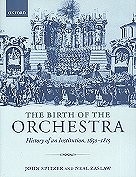|
This book traces the
emergence of the orchestra from 16th-century string bands to the
'classical' orchestra of Haydn, Mozart, Beethoven, and their contemporaries.
Ensembles of bowed stringed instruments, several players per part, were
organized in Versailles and Paris in the mid-seventeenth
century and then in Rome at the end of the
century. Continuo and wind instruments were often added to these string
bands.
The prestige of these
ensembles and of the music and performing styles of their leaders,
Jean-Baptist Lully and Arcangelo Corelli, caused them to be imitated
elsewhere, until by the late 18th century, the orchestra had
become a pan-European phenomenon.
Spitzer and Zaslaw review previous accounts of these developments, then proceed to a thoroughgoing documentation and
discussion of orchestral organization, instrumentation, and social roles in France, Italy, Germany, England, and the American
colonies. They also examine the emergence of orchestra musicians, idiomatic
music for orchestras, orchestral performance practices, and the awareness of
the orchestra as a central institution in European life.
John Spitzer studied European history
and literature at Harvard, where his teachers included Reuben Brower and
Barrington Moore. He went on to study musicology and ethnomusicology at Cornell University with William Austin,
James Webster, Sotiros Chianis,
and Bell Yung. He held a Postdoctoral Fellowship at the University of Pittsburg (1983-84), and taught
at the University of Michigan (1984-87). In 1987 he
joined the faculty of the Peabody Conservatory of Johns Hopkins University.
He has published scholarly articles on seventeenth- and eighteenth century
music, on authorship in music and art, and on American song, as well as music
reviews and articles in newspapers, magazines, dictionaries, and
encyclopedias.
Neal Zaslaw holds degrees from Harvard, the Julliard School, and Columbia University. He is the author of
more than 65 articles on baroque music, historical performance practices,
Mozart, and the early history of the orchestra, as well as author or editor
of several books, including Mozart's Symphonies: Context, Performance
Practice Reception (Oxford 1989), The Classical Era from the 1740s to
the End of the 18th Century (Macmillan, 1989), and, most
recently, Mozart's Piano Concertos: Text, Context, Interpretation
(University of Michigan Press, 1995). A member of the Zentral
Institut der Internationale Stiftung Mozarteum and the American Academy of Arts & Sciences,
Zaslaw has taught at Cornell University since 1970.
|

|
